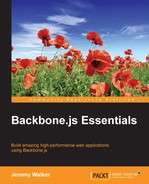With that explanation out of the way, we can finally get down to the workings of Backbone's subclassing system, which revolves around Backbone's extend method. To use extend, you simply call it from the class that your new subclass will be based on, and extend will return the new subclass. This new subclass will have its __proto__ property set to the prototype property of its parent class, allowing objects created with the new subclass to access all the properties and methods of the parent class. Take an example of the following code snippet:
var Book = Backbone.Model.extend(); // Book.prototype.__proto__ == Backbone.Model.prototype; var book = new Book(); book.destroy();
In the preceding example, the last line works because JavaScript will look up the __proto__ chain, find the Model method destroy, and use it. In other words, all the functionality of our original class has been inherited by our new class.
But of course, extend wouldn't be exciting if all it can do is make exact clones of the parent classes, which is why extend takes a properties object as its first argument. Any properties or methods on this object will be added to the new class's prototype. For instance, let's try making our Book class a little more interesting by adding a property and a method:
var Book = Backbone.Model.extend({
currentPage: 1,
turnPage: function() {
this.currentPage += 1;
}
});
var book = new Book();
book.currentPage; // == 1
book.turnPage(); // increments book.currentPage by oneThe extend method also allows you to create static properties or methods, or in other words, properties or methods that live on the class rather than on objects created from that class. These static properties and methods are passed in as the second classProperties argument to extend. Here's a quick example of how to add a static method to our Book class:
var Book = Backbone.Model.extend({}, {
areBooksGreat: function() {
alert("yes they are!");
}
});
Book.areBooksGreat(); // alerts "yes they are!"
var book = new Book();
book.areBooksGreat(); // fails because static methods must be called on a classAs you can see, there are several advantages to Backbone's approach to inheritance over the native JavaScript approach. First, the word prototype did not appear even once in any of the previously mentioned code; while you still need to understand how prototype works, you don't have to think about it just to create a class. Another benefit is that the entire class definition is contained within a single extend call, keeping all of the class's parts together visually. Also, when we use extend, the various pieces of logic that make up the class are ordered the same way as in most other programming languages, defining the super class first and then the initializer and properties, instead of the other way around.
